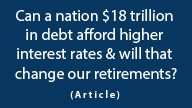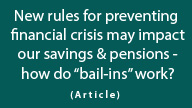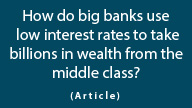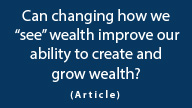Will Ever More Boomers Selling Retirement Assets Change Investment Prices For Decades?
by Daniel R. Amerman, CFA
Below is the 2nd half of this article, and it begins where the 1st half which is carried on other websites left off. If you would prefer to read (or link) the article in single page form, the private one page version for subscribers can be found here:
The Five Factors
When that time does come that most of the Baby Boom have retired and are starting to liquidate their retirement portfolios or draw down their pensions – or both – we are going to see five distinct but interrelated impacts on cash flow:
1) Their retirement plan investment cash is no longer going into the markets
2) Their earnings and profits are no longer being reinvested
3) Their employer’s pension plan is no longer buying investments for them
4) The associated pension earnings and profits are no longer being reinvested
5) Other investors have to come up with the cash to buy out their portfolio and pension investments, cash that will not be available for other investments.
For going on 35 years now, those first four factors have been building and pouring more cash into the markets each year, supporting them and steadily lifting prices, while smoothing out the rough areas – even as they increased the paper value of all those portfolios and pension plans. When the time comes for people to actually cash in on that value however, with their counting on prices much higher than today – the tide will be going out fast. How much will that lower the prices?
Now one could argue that millions of people have retired before and sold investments without crashing market prices. That is certainly true, and millions of people are currently drawing down investment portfolios in retirement right now. One could also say that even with as large as the Baby Boom is, there will still be more people investing than divesting, thus more savers than people cashing out – and that would be true as well.
What's crucial to take into account however is not simply people, but total cash in versus total cash out. That is, when we get past the government accounting shenanigans, as covered here, what really matters with Social Security is the number of people paying into it, versus the number of people collecting benefits. And by the time the Baby Boom has fully retired, we will be down to about two people paying in for each person collecting (according to Social Security Administration projections), which is the heart of the true problem facing Social Security.
While that ratio is widely acknowledged, what has generally been overlooked is that the exact same demographics will also be applying to retirement investing, pensions and the markets as a whole. For investments do not exist in some isolated world of their own apart from the rest of society.
If we look at the long-term history of the markets (for our comfort from long-term rates of return), they are based on ratios such as what existed in 1950 when there were 16 workers for every one retiree. For stark comparison, by 2030 we will be down to about two people saving for retirement for every one person who is selling securities to fund their retirements.
Now there is of course more to the markets and investing than just retirement investing. Other retirement investors will not be your own sole source of cash, and inflation also needs to be taken into account. However, the shift in population demographics along with behavior, laws and perceptions that has led to about fifty million Baby Boomers becoming investors – has profoundly impacted the markets.
Financial markets feed and thrive on cash, and every month for decades the markets have been swelling with portfolio and pension contributions, as well as the more important reinvestment of portfolio and pension investment earnings. These four supporting pillars of the market will first be neutralized, and will then reverse altogether, sucking cash out of the markets instead of adding back in.
The very powerful cumulative effect of these changes is necessarily negative on the prices that Baby Boom investors will receive for their investments. Cash flowing into the markets and the demand for long term investments will be steadily falling even as a larger supply of investments is offered for sale each year, as the entire Baby Boom gradually retires and starts to cash in, as well as enjoy the hard-earned benefits of their pensions.
How negative will the effect be? Financial history would usually be a good place to look for answers, but unfortunately, history can't offer guidance here. That is because none of this has ever happened before. In the not-too-distant past, most people were too poor to accrue any savings, and they died too soon to enjoy them anyway.
There are about fifty million Boomers who have retirement accounts, pensions or both. We have never had fifty million people expecting to be supported directly or indirectly through the ongoing sale of investments. Over the last 35 years, we’ve seen what the largest and wealthiest generation can to do the markets when most of them are simultaneously buying – but we have no history for what happens to prices when so many people try to cash out so much for so long.
We are all conducting a great experiment, together.
 What you have just read is an "eye-opener" about one aspect of the often hidden redistributions of wealth that go on all around us, every day.
What you have just read is an "eye-opener" about one aspect of the often hidden redistributions of wealth that go on all around us, every day.
 A personal retirement "eye-opener" linked here shows how the government's actions to reduce interest payments on the national debt can reduce retirement investment wealth accumulation by 95% over thirty years, and how the government is reducing standards of living for those already retired by almost 50%.
A personal retirement "eye-opener" linked here shows how the government's actions to reduce interest payments on the national debt can reduce retirement investment wealth accumulation by 95% over thirty years, and how the government is reducing standards of living for those already retired by almost 50%.
 An "eye-opener" tutorial of a quite different kind is linked here, and it shows how governments use inflation and the tax code to take wealth from unknowing precious metals investors, so that the higher inflation goes, and the higher precious metals prices climb - the more of the investor's net worth ends up with the government.
An "eye-opener" tutorial of a quite different kind is linked here, and it shows how governments use inflation and the tax code to take wealth from unknowing precious metals investors, so that the higher inflation goes, and the higher precious metals prices climb - the more of the investor's net worth ends up with the government.
 When we look at all government retirement promises over the coming decades – the total is simply unpayable. As explored in the "eye opener" linked here, this means that there is a high probability of an eventual tax code "revolution" that could rewrite all the rules when it comes to the future treatment of our current retirement accounts.
When we look at all government retirement promises over the coming decades – the total is simply unpayable. As explored in the "eye opener" linked here, this means that there is a high probability of an eventual tax code "revolution" that could rewrite all the rules when it comes to the future treatment of our current retirement accounts.







If you find these "eye-openers" to be interesting and useful, there is an entire free book of them available here, including many that are only in the book. The advantage to the book is that the tutorials can build on each other, so that in combination we can find ways of defending ourselves, and even learn how to position ourselves to benefit from the hidden redistributions of wealth.
























